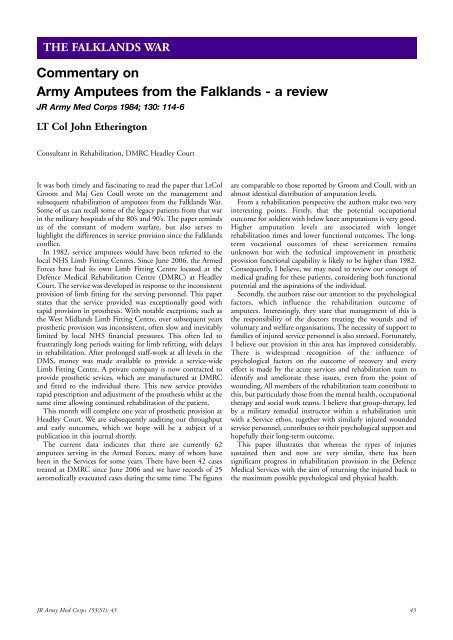Falklands war 25TH anniversarY - Boekje Pienter
Falklands war 25TH anniversarY - Boekje Pienter
Falklands war 25TH anniversarY - Boekje Pienter
You also want an ePaper? Increase the reach of your titles
YUMPU automatically turns print PDFs into web optimized ePapers that Google loves.
THE FALKLANDS WAR<br />
Commentary on<br />
Army Amputees from the <strong>Falklands</strong> - a review<br />
JR Army Med Corps 1984; 130: 114-6<br />
LT Col John Etherington<br />
Consultant in Rehabilitation, DMRC Headley Court<br />
It was both timely and fascinating to read the paper that LtCol<br />
Groom and Maj Gen Coull wrote on the management and<br />
subsequent rehabilitation of amputees from the <strong>Falklands</strong> War.<br />
Some of us can recall some of the legacy patients from that <strong>war</strong><br />
in the military hospitals of the 80’s and 90’s. The paper reminds<br />
us of the constant of modern <strong>war</strong>fare, but also serves to<br />
highlight the differences in service provision since the <strong>Falklands</strong><br />
conflict.<br />
In 1982, service amputees would have been referred to the<br />
local NHS Limb Fitting Centres. Since June 2006, the Armed<br />
Forces have had its own Limb Fitting Centre located at the<br />
Defence Medical Rehabilitation Centre (DMRC) at Headley<br />
Court. The service was developed in response to the inconsistent<br />
provision of limb fitting for the serving personnel. This paper<br />
states that the service provided was exceptionally good with<br />
rapid provision in prosthesis. With notable exceptions, such as<br />
the West Midlands Limb Fitting Centre, over subsequent years<br />
prosthetic provision was inconsistent, often slow and inevitably<br />
limited by local NHS financial pressures. This often led to<br />
frustratingly long periods waiting for limb refitting, with delays<br />
in rehabilitation. After prolonged staff-work at all levels in the<br />
DMS, money was made available to provide a service-wide<br />
Limb Fitting Centre. A private company is now contracted to<br />
provide prosthetic sevices, which are manufactured at DMRC<br />
and fitted to the individual there. This new service provides<br />
rapid prescription and adjustment of the prosthesis whilst at the<br />
same time allowing continued rehabilitation of the patient.<br />
This month will complete one year of prosthetic provision at<br />
Headley Court. We are subsequently auditing our throughput<br />
and early outcomes, which we hope will be a subject of a<br />
publication in this journal shortly.<br />
The current data indicates that there are currently 62<br />
amputees serving in the Armed Forces, many of whom have<br />
been in the Services for some years. There have been 42 cases<br />
treated at DMRC since June 2006 and we have records of 25<br />
aeromedically evacuated cases during the same time. The figures<br />
are comparable to those reported by Groom and Coull, with an<br />
almost identical distribution of amputation levels.<br />
From a rehabilitation perspective the authors make two very<br />
interesting points. Firstly, that the potential occupational<br />
outcome for soldiers with below knee amputations is very good.<br />
Higher amputation levels are associated with longer<br />
rehabilitation times and lower functional outcomes. The longterm<br />
vocational outcomes of these servicemen remains<br />
unknown but with the technical improvement in prosthetic<br />
provision functional capability is likely to be higher than 1982.<br />
Consequently, I believe, we may need to review our concept of<br />
medical grading for these patients, considering both functional<br />
potential and the aspirations of the individual.<br />
Secondly, the authors raise our attention to the psychological<br />
factors, which influence the rehabilitation outcome of<br />
amputees. Interestingly, they state that management of this is<br />
the responsibility of the doctors treating the wounds and of<br />
voluntary and welfare organisations. The necessity of support to<br />
families of injured service personnel is also stressed. Fortunately,<br />
I believe our provision in this area has improved considerably.<br />
There is widespread recognition of the influence of<br />
psychological factors on the outcome of recovery and every<br />
effort is made by the acute services and rehabilitation team to<br />
identify and ameliorate these issues, even from the point of<br />
wounding. All members of the rehabilitation team contribute to<br />
this, but particularly those from the mental health, occupational<br />
therapy and social work teams. I believe that group-therapy, led<br />
by a military remedial instructor within a rehabilitation unit<br />
with a Service ethos, together with similarly injured wounded<br />
service personnel, contributes to their psychological support and<br />
hopefully their long-term outcome.<br />
This paper illustrates that whereas the types of injuries<br />
sustained then and now are very similar, there has been<br />
significant progress in rehabilitation provision in the Defence<br />
Medical Services with the aim of returning the injured back to<br />
the maximum possible psychological and physical health.<br />
JR Army Med Corps 153(S1): 43 43

















